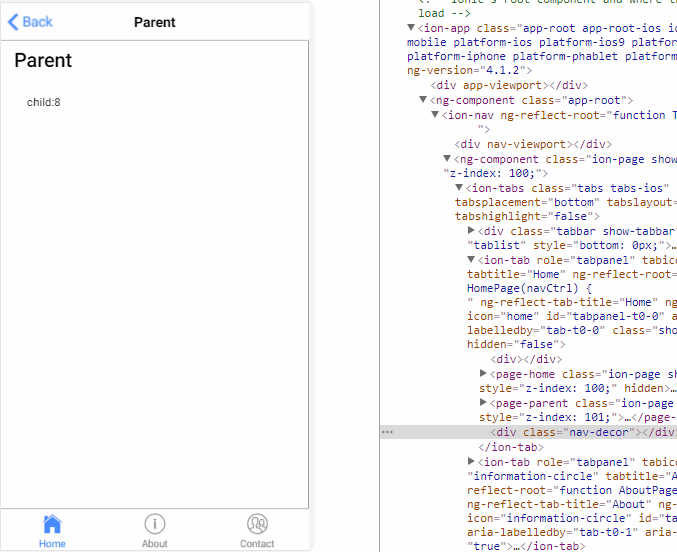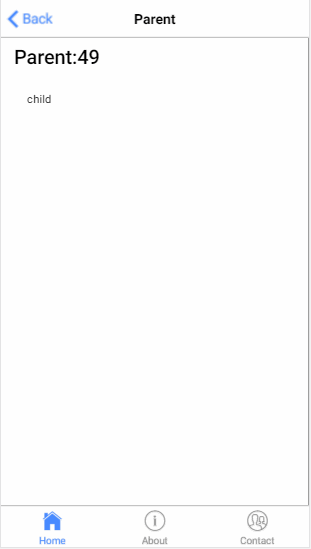Angular4 组件通讯方法大全
组件通讯,意在不同的指令和组件之间共享信息。如何在两个多个组件之间共享信息呢。
最近在项目上,组件跟组件之间可能是父子关系,兄弟关系,爷孙关系都有。。。。。我也找找了很多关于组件之间通讯的方法,不同的方法应用在不同的场景,根据功能需求选择组件之间最适合的通讯方式。下面我就总结一下关于组件通讯的N多种方法。
1.父→子 input
parent.ts
import { Component } from '@angular/core';
@Component({
selector: 'page-parent',
templateUrl: 'parent.html',
})
export class ParentPage {
i: number = ;
constructor() {
setInterval(() => {
this.i++;
}, )
}
}
parent.html
<ion-header>
<ion-navbar>
<ion-title>Parent</ion-title>
</ion-navbar>
</ion-header> <ion-content padding>
<h2>Parent</h2>
<page-child [content]="i"></page-child>
</ion-content>
child.ts
import { Component,Input } from '@angular/core';
@Component({
selector: 'page-child',
templateUrl: 'child.html',
})
export class ChildPage {
@Input() content:string;
constructor() {
}
}
child.html <ion-content padding>
child:{{content}}
</ion-content>
结果:

2.子→父 output
parent.ts
import { Component } from '@angular/core';
@Component({
selector: 'page-parent',
templateUrl: 'parent.html',
})
export class ParentPage {
i: number = ;
numberIChange(i:number){
this.i = i;
}
}
parent.html
<ion-header>
<ion-navbar>
<ion-title>Parent</ion-title>
</ion-navbar>
</ion-header> <ion-content padding>
<h2>Parent:{{i}}</h2>
<page-child (changeNumber)="numberIChange($event)"></page-child>
</ion-content>
child.ts
import { Component, EventEmitter, Output } from '@angular/core';
@Component({
selector: 'page-child',
templateUrl: 'child.html',
})
export class ChildPage {
@Output() changeNumber: EventEmitter<number> = new EventEmitter();
Number: number = ;
constructor() {
setInterval(() => {
this.changeNumber.emit(++this.Number);
}, )
}
}
child.html <ion-content padding>
child
</ion-content>
结果:

3.子获得父实例
parent.ts
import { Component } from '@angular/core';
@Component({
selector: 'page-parent',
templateUrl: 'parent.html',
})
export class ParentPage {
i:number = ;
}
parent.html <ion-header>
<ion-navbar>
<ion-title>Parent</ion-title>
</ion-navbar>
</ion-header> <ion-content padding>
<h1>parent: {{i}}</h1>
<page-child></page-child>
</ion-content>
child.ts
import { Component, Input, EventEmitter, Output,Host,Inject,forwardRef } from '@angular/core';
import{ParentPage} from '../parent/parent';
@Component({
selector: 'page-child',
templateUrl: 'child.html',
})
export class ChildPage {
constructor( @Host() @Inject(forwardRef(() => ParentPage)) app: ParentPage) {
setInterval(() => {
app.i++;
}, );
}
}
child.html <ion-content padding>
child
</ion-content>
结果:

4.父获得子实例
parent.ts
import {ViewChild, Component } from '@angular/core';
import{ChildPage}from '../child/child';
@Component({
selector: 'page-parent',
templateUrl: 'parent.html',
})
export class ParentPage {
@ViewChild(ChildPage) child:ChildPage;
ngAfterViewInit() {
setInterval(()=> {
this.child.i++;
}, )
}
}
parent.html <ion-header>
<ion-navbar>
<ion-title>Parent</ion-title>
</ion-navbar>
</ion-header> <ion-content padding>
<h1>parent {{i}}</h1>
<page-child></page-child>
</ion-content>
child.ts
import { Component, Input, EventEmitter, Output,Host,Inject,forwardRef } from '@angular/core';
@Component({
selector: 'page-child',
templateUrl: 'child.html',
})
export class ChildPage {
i:number = ;
}
child.html <ion-content padding>
<h2>child {{i}}</h2>
</ion-content>
结果:

5.service
parent.ts
import { Component } from '@angular/core';
import{myService}from '../child/myService'
@Component({
selector: 'page-parent',
templateUrl: 'parent.html',
})
export class ParentPage {
constructor(service:myService) {
setInterval(()=> {
service.i++;
}, )
}
}
parent.html <ion-header>
<ion-navbar>
<ion-title>Parent</ion-title>
</ion-navbar>
</ion-header> <ion-content padding>
<h1>parent {{i}}</h1>
<page-child></page-child>
</ion-content>
child.ts
import { Component} from '@angular/core';
import{myService}from "../child/myService"
@Component({
selector: 'page-child',
templateUrl: 'child.html',
})
export class ChildPage {
constructor(public service:myService){
}
}
child.html <ion-content padding>
<h2>child {{service.i}}</h2>
</ion-content>
myService.ts
ps:记得在app.module.ts 加上providers: [KmyService]
import{Injectable } from '@angular/core';
@Injectable()
export class KmyService {
i:number = ;
}
结果:

6.EventEmitter
myService.ts
import {Component,Injectable,EventEmitter} from '@angular/core';
@Injectable()
export class myService {
change: EventEmitter<number>;
constructor(){
this.change = new EventEmitter();
}
}
parent.ts
import { Component } from '@angular/core';
import{myService}from '../child/myService'
@Component({
selector: 'page-parent',
templateUrl: 'parent.html',
})
export class ParentPage {
i:number = ;
constructor(service:myService) {
setInterval(()=> {
service.change.emit(++this.i);
}, )
}
}
parent.html <ion-header>
<ion-navbar>
<ion-title>Parent</ion-title>
</ion-navbar>
</ion-header> <ion-content padding>
<h1>parent {{i}}</h1>
<page-child></page-child>
</ion-content>
child.ts
import { Component, EventEmitter} from '@angular/core';
import{myService}from "../child/myService"
@Component({
selector: 'page-child',
templateUrl: 'child.html',
})
export class ChildPage {
i:number = ;
constructor(public service:myService){
service.change.subscribe((value:number)=>{
this.i = value;
})
}
}
child.html <ion-content padding>
<h2>child {{i}}</h2>
</ion-content>
结果:

7.订阅
parent.ts
import { Component } from '@angular/core';
import{myService}from '../child/myService'
@Component({
selector: 'page-parent',
templateUrl: 'parent.html',
})
export class ParentPage {
i:number=;
constructor(public service:myService) {
setInterval(()=> {
this.service.StatusMission(this.i++);
}, )
}
}
parent.html <ion-header>
<ion-navbar>
<ion-title>Parent</ion-title>
</ion-navbar>
</ion-header> <ion-content padding>
<h1>parent</h1>
<page-child></page-child>
</ion-content>
child.ts
import { Component, Injectable } from '@angular/core'
import { myService } from "../child/myService"
import { Subscription } from 'rxjs/Subscription';
@Component({
selector: 'page-child',
templateUrl: 'child.html',
})
export class ChildPage {
i:number=;
subscription: Subscription;
constructor(private Service: myService) {
this.subscription = Service.Status$.subscribe(message => {
this.i=message;
});
}
ngOnDestroy() {
this.subscription.unsubscribe();
}
}
child.html <ion-content padding>
<h2>child {{i}}</h2>
</ion-content>
myService.ts
import { Injectable } from '@angular/core';
import { Subject } from 'rxjs/Subject';
@Injectable()
export class myService {
private Source=new Subject<any>();
Status$=this.Source.asObservable();
StatusMission(message: any) {
this.Source.next(message);
}
}
结果:

以上七种组件与组件的通讯方式,可以选择应用于适合的场景里面,根据情况吧。
此随笔乃本人原创,如有疑问欢迎在下面评论,转载请标明出处。
如果对您有帮助请动动鼠标右下方给我来个赞,您的支持是我最大的动力。
Angular4 组件通讯方法大全的更多相关文章
- [转载]Angular4 组件通讯方法大全
组件通讯,意在不同的指令和组件之间共享信息.如何在两个多个组件之间共享信息呢. 最近在项目上,组件跟组件之间可能是父子关系,兄弟关系,爷孙关系都有.....我也找找了很多关于组件之间通讯的方法,不同的 ...
- vue组件通讯方法汇总(在不使用vuex的情况下)
前三种是父子组件通讯,最后一种是平级组件.
- angular4 组件通讯、生命周期
主要通讯形式 父组件通过属性绑定到子组件,子组件通过事件传递参数到父组件 父组件通过局部变量获取子组件的引用 父组件使用@ViewChild获取子组件的引用 两个不相关联的组件使用中间人模式交互 终极 ...
- Omi教程-组件通讯攻略大全
组件通讯 Omi框架组建间的通讯非常遍历灵活,因为有许多可选方案进行通讯: 通过在组件上声明 data-* 传递给子节点 通过在组件上声明 data 传递给子节点 (支持复杂数据类型的映射) 父容器设 ...
- Omi教程-组件通讯
组件通讯 Omi框架组建间的通讯非常遍历灵活,因为有许多可选方案进行通讯: 通过在组件上声明 data-* 传递给子节点 通过在组件上声明 data 传递给子节点 父容器设置 childrenData ...
- 【Vue】Vue中的父子组件通讯以及使用sync同步父子组件数据
前言: 之前写过一篇文章<在不同场景下Vue组件间的数据交流>,但现在来看,其中关于“父子组件通信”的介绍仍有诸多缺漏或者不当之处, 正好这几天学习了关于用sync修饰符做父子组件数据双向 ...
- ng组件通讯的几种方式
通过输入型绑定把数据从父组件传到子组件. 如<app-hero-child *ngFor="let hero of heroes" [hero]="hero&qu ...
- Omi框架学习之旅 - 通过对象实例来实现组件通讯 及原理说明
组件通讯不是讲完了吗(上帝模式还没讲哈),怎么又多了种方式啊. 你484傻,多一种选择不好吗? 其实这个不属于组件通讯啦,只是当父组件实例安装和渲染完毕后,可以执行installed这个方法(默认是空 ...
- angular2组件通讯的几种方式
最近刚刚接触angular2,对ng2也是一知半解,如有说得不对的地方欢迎指出,欢迎加q共同探讨学习991085978: 1.通过输入型绑定把数据从父组件传到子组件 HeroChildComponen ...
随机推荐
- Python3实现简单的http server
前端的开发的html给我们的时候,由于内部有一些ajax请求的.json的数据,需要在一个web server中查看,每次放到http服务器太麻烦.还是直接用python造一个最方便. 最简单的,直接 ...
- iOS开发之常用资讯类App的分类展示与编辑的完整案例实现(Swift版)
上篇博客我们聊了<资讯类App常用分类控件的封装与实现(CollectionView+Swift3.0)>,今天的这篇博客就在上篇博客的基础上做些东西.做一个完整的资讯类App中的分类展示 ...
- NLTK学习笔记(八):文法--词关系研究的工具
[TOC] 对于一门语言来说,一句话有无限可能.问题是我们只能通过有限的程序来分析结构和含义.尝试将"语言"理解为:仅仅是所有合乎文法的句子的大集合.在这个思路的基础上,类似于 w ...
- git常用命令,助你快速入门
git是程序员中最常用的版本控制工具,学会git的基本使用是十分重要,特别是在公司里面的协同开发,废话不多说,下面贴出常用的命令. 1.基本配置 # 既然git是多人协同的工具,别人要看到你提交代码的 ...
- BeanUtils.copyProperties()方法引入不同包
两个对象之间拷贝相同的属性,可以使用BeanUtils.copyProperties()方法, BeanUtils.copyProperties(obj1,obj2); 提示有三个包可选. A,选择o ...
- ant使用
摘录于他人精华,原文出处http://www.blogjava.net/hoojo/archive/2013/06/14/400550.html 1.project 节点元素 project 元素是 ...
- 我的学习之路_第二十章_JDBC
JDBC 使用JDBC技术,通过mysql提供的驱动程序,操作数据库 ● 1. 注册驱动 告知jvm 使用的是什么驱动程序(mysql,oracle) 使用API中的类 DriverManager中的 ...
- tomcat运行war包报错,找不到context-root文件
今天在部署项目的时候遇到了这个问题,查看Tomcat日志/logs/cataline.out这个文件. 里面有一句:can not open .....[context-root.xml], 进过很长 ...
- 常用PHP函数的封装
PHP获取文件扩展名(后缀) function getExtension($filename){ $myext = substr($filename, strrpos($filename, '.')) ...
- JavaScript对象属性访问的两种方式
JavaScript对象属性访问的两种方式 object.attribute object["attribute"] 例如: var employees = [ { "f ...
